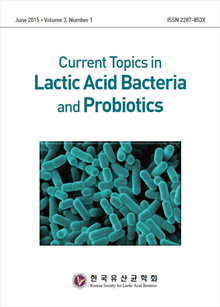간행물
Current Topic in Lactic Acid Bacteria and Probiotics KCI 등재후보 한국유산균·프로바이오틱스학회지

- 발행기관 한국유산균·프로바이오틱스학회
- 자료유형 학술지
- 간기 반년간
- ISSN 2287-853X (Print)
- 수록기간 2013 ~ 2024
- 주제분류 의약학 > 생리학 의약학 분류의 다른 간행물
- 십진분류KDC 573DDC 663
권호리스트/논문검색
Vol. 9. No. 1 (2023년 6월) 6건
1.
2023.06
서비스 종료(열람 제한)
Exposure to lipopolysaccharide (LPS) causes cognitive impairment (CI). In the preliminary study, Lactobacillus gasseri NK109 suppressed LPS-induced expression of proinflammatory cytokines in macrophages. Therefore, the effect of NK109 on LPS-increased CI was investigated in mice. Intraperitoneal injection of LPS caused CI-like behaviors and neuroinflammation. However, orally administered NK109 reduced LPS-increased CI-like behaviors and hippocampal IL-1β and TNF-α expression, whereas LPS-decreased BDNF expression increased. NK109 also reduced LPS-increased colonic myeloperoxidase, IL-1β, and TNF-α expression. The efficacy of NK109 was increased by the combination of soybean embryo ethanol extract (SE). These findings suggest that NK109 with SE can improve CI by alleviating inflammation-mediated BDNF expression, thereby being beneficial for dementia therapy.
2.
2023.06
서비스 종료(열람 제한)
Dental caries is an infectious disease accompanied by the destruction of teeth. It is a multifactorial disease caused by the interaction between microbes in dental plaque and food, with cariogenic Streptococcus mutans being one of the primary causes. In this study, the antimicrobial and antibiofilm activities of Lactiplantibacillus plantarum THK-j112 isolated from Kimchi, a traditional fermented food, against S. mutans were investigated. Furthermore, this paper also showed the possibility of developing this strain. After analyzing the 16S rRNA sequence, strain THK-j112 was named L. plantarum THK-j112 as it shared 99.93% similarity with L. plantarum ATCC 14917T. Both L. plantarum THK-j112 and L. plantarum ATCC 14917T demonstrated MIC values of 5 mg/mL and MBC values of 10 mg/mL against S. mutans KACC 16833T. The study confirmed that L. plantarum THK-j112 exhibited significant concentration-dependent inhibitory effects on biofilm formation, acid production, and glucosyltransferases(GTFs) production. Regarding hemolytic activity, Bacillus cereus ATCC 14579T, used as a positive control, was confirmed to cause hemolysis, whereas L. plantarum THK-j112 did not cause this phenomenon. Additionally, except for gentamicin, the antibiotic resistance test revealed a lower value than the MIC cut-off value for each antibiotic, indicating no resistance. Based on the findings, L. plantarum THK-j112 is expected to be useful in the food industry, such as functional food, as a lactic acid bacterium with antimicrobial and antibiofilm effects.
3.
2023.06
서비스 종료(열람 제한)
In probiotics production, lactic acid bacteria (LAB) are cultured on a large scale to achieve efficient processing through fermentation optimization and scale-up. In this Current study, the LAB strain Lactiplantibacillus plantarum WiKim0125 was isolated from kimchi and optimized the production. The optimization strategy for cultivating L. plantarum WiKim0125 consisted of investigating media components, selecting physiochemical conditions to enhance productivity, and scaling up for pilot-scale production. Each process condition was evaluated based on substrate consumption, lactic acid production, and viable cell yield. As a result, the final viable cell and lactic acid yield of L. plantarum WiKim0125 increased by 38.6% and 19.4%, respectively. This study provides an overview of fermentation optimization and scale-up processes for the industrial application of L. plantarum WiKim0125.
4.
2023.06
서비스 종료(열람 제한)
Screening of Bacillus subtilis strains capable of producing extracellular hydrolases, including lipolytic enzyme was carried out. Within the scope of this study, total 61 strains were isolated from various domestic specific environmental samples such as seawater, soil, Jeju ranch, hot spring, salt farm, and fermented food and identified as Bacillus subtilis based on 16S rRNA sequences. Among the isolates, 4 strains had extracellular lipase activity. The growth profile of the strains revealed that 4 strains showed well growth at 50℃, 3 strains at 55℃, and pH 7.0. All strains could tolerate salinity up to 5%(w/v), 3 strains up to 10%(w/v), and only one strain showed growth at 15%(w/v). Additionally, amylolytic and proteolytic activities were detected in these strains. The highest lipolytic, amylolytic, and proteolytic activity was detected in Bacillus subtilis YS-YR 5A. These results demonstrate the potential application of extracellular hydrolase-producing Bacillus subtilis strains, especially strain YS-YR 5A, as fermentation starter to enhance the functionality and multiplication of functional natural products in the food/medicine/cosmetics/bio industries.
5.
2023.06
서비스 종료(열람 제한)
Dental caries is an infectious disease that is caused by the interaction between the host, the diet, and a diverse microbial community. This study illustrated the anticariogenic effects of THYJ-15 against Streptococcus mutans, a major agent of dental caries. THYJ-15 was identified as Latilactobacillus sakei subsp. sakei through 16S rRNA sequencing, with a similarity of 99.72% to L. sakei subsp. sakei JCM 1157T. The cell-free supernatant of L. sakei subsp. sakei THYJ-15 observed MIC values of 10 mg/mL and MBC values of 20 mg/mL against S. mutans KACC 16833T. The cell-free supernatant of L. sakei subsp. sakei THYJ-15 showed significant inhibitory effects on biofilm formation, acid production and glucosyltransferases(GTFs) production against S. mutans. As a results, it was confirmed that L. sakei subsp. sakei THYJ-15 is a lactic acid bacterium possessing notable anticariogenic effects. Accordingly, L. sakei subsp. sakei THYJ-15 is expected to have great potential to be used as a basic substance for dental caries treatment caused by S. mutans.
6.
2023.06
서비스 종료(열람 제한)
This research focused on the isolation and characterization of the new strains which can be used as microbial resources for auxin production in the agriculture industry. For the isolation of the new microorganism in the gut of Larimichthys polyactis, a marine agar medium was used and 3 colonies were isolated. Through the 16S-based ID service, isolated strains were identified as 1 strain of Niallia circulans and 3 strains of Proteus mirabilis. Verifying the agriculture industrial values of these isolated strains, the productivity of auxin and activity of various enzymes such as amylase, lipase, and protease were confirmed. As a result, isolated 3 strains showed auxin activity and only protease activities which means the possibility of applying them to the production of effective microorganisms in the agriculture industry.

